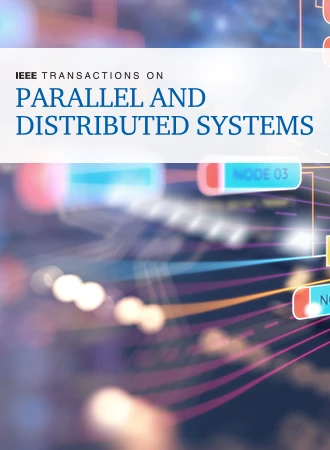ViTeGNN: Towards Versatile Inference of Temporal Graph Neural Networks on FPGA
IF 5.6
2区 计算机科学
Q1 COMPUTER SCIENCE, THEORY & METHODS
IEEE Transactions on Parallel and Distributed Systems
Pub Date : 2024-12-24
DOI:10.1109/TPDS.2024.3521897
引用次数: 0
Abstract
Temporal Graph Neural Networks (TGNNs) are powerful models to capture temporal, structural, and contextual information on temporal graphs, outperforming other methods in many high-impact downstream tasks. However, achieving high-performance TGNN inference in production environments is challenging because TGNN models suffer from high computation complexity and intrinsic temporal data dependency that hinders data parallelism. In addition, real-world TGNN applications have different latency and throughput requirements. This work presents ViTeGNN, a versatile TGNN inference solution for memory-based TGNNs on FPGAs. ViTeGNN performs algorithm-model-architecture co-design to meet the latency and throughput requirements of real-world TGNN applications. Besides the vanilla inference mode ViTeGNN-bal that updates embeddings for nodes interacting with others, we propose ViTeGNN-lat and ViTeGNN-thpt, optimized for latency and throughput. Our model optimizations include a lightweight method to compute attention scores and a related temporal neighbor pruning strategy to reduce computation and memory accesses. These are holistically coupled with key hardware optimizations that leverage the FPGA hardware. We propose a novel hardware module to execute the complex neighbor update process efficiently. To ensure similar accuracy vis-á-vis the original model, the simplified models are trained using the knowledge distillation technique. We propose a unified hardware design that supports all of these three inference modes without FPGA reconfiguration. Enabled by our flexible hardware architecture, we further propose ViTeGNN-auto, which automatically selects the best inference mode at runtime based on latency and throughput requirements, guided by our accurate performance model. We evaluate the performance of the proposed hardware accelerator on five real-world datasets. ViTeGNN-bal reduces the computation complexity by an average of 62% and memory accesses by an average of 36% with only 0.0042 accuracy loss. Compared with state-of-the-art implementations on CPU and GPU, our FPGA implementation achieves在FPGA上实现时间图神经网络的多用途推理
时间图神经网络(tgnn)是捕获时间图上的时间、结构和上下文信息的强大模型,在许多高影响下游任务中优于其他方法。然而,在生产环境中实现高性能TGNN推理是具有挑战性的,因为TGNN模型具有高计算复杂性和内在的时间数据依赖性,从而阻碍了数据并行性。此外,实际的TGNN应用程序具有不同的延迟和吞吐量需求。这项工作提出了ViTeGNN,一种用于fpga上基于内存的TGNN的通用TGNN推理解决方案。ViTeGNN执行算法-模型-架构协同设计,以满足实际TGNN应用的延迟和吞吐量要求。除了更新与其他节点交互的节点嵌入的普通推理模式ViTeGNN-bal之外,我们还提出了针对延迟和吞吐量进行优化的ViTeGNN-lat和ViTeGNN-thpt。我们的模型优化包括计算注意力分数的轻量级方法和相关的时间邻居修剪策略,以减少计算和内存访问。这些整体上与利用FPGA硬件的关键硬件优化相结合。我们提出了一种新的硬件模块来有效地执行复杂的邻居更新过程。为了保证与-á-vis原始模型相似的精度,使用知识蒸馏技术对简化模型进行训练。我们提出了一种统一的硬件设计,支持所有这三种推理模式,而无需FPGA重新配置。在我们灵活的硬件架构的支持下,我们进一步提出了ViTeGNN-auto,它在我们精确的性能模型的指导下,根据延迟和吞吐量需求在运行时自动选择最佳推理模式。我们在五个真实数据集上评估了所提出的硬件加速器的性能。ViTeGNN-bal的计算复杂度平均降低62%,内存访问平均降低36%,精度损失仅为0.0042。与最先进的CPU和GPU实现相比,我们的FPGA实现在ViTeGNN-lat/-bal/-thpt上分别实现了53.9/26.0/16.1倍和8.2/4.0/2.5倍的加速。
本文章由计算机程序翻译,如有差异,请以英文原文为准。
求助全文
约1分钟内获得全文
求助全文
来源期刊

IEEE Transactions on Parallel and Distributed Systems
工程技术-工程:电子与电气
CiteScore
11.00
自引率
9.40%
发文量
281
审稿时长
5.6 months
期刊介绍:
IEEE Transactions on Parallel and Distributed Systems (TPDS) is published monthly. It publishes a range of papers, comments on previously published papers, and survey articles that deal with the parallel and distributed systems research areas of current importance to our readers. Particular areas of interest include, but are not limited to:
a) Parallel and distributed algorithms, focusing on topics such as: models of computation; numerical, combinatorial, and data-intensive parallel algorithms, scalability of algorithms and data structures for parallel and distributed systems, communication and synchronization protocols, network algorithms, scheduling, and load balancing.
b) Applications of parallel and distributed computing, including computational and data-enabled science and engineering, big data applications, parallel crowd sourcing, large-scale social network analysis, management of big data, cloud and grid computing, scientific and biomedical applications, mobile computing, and cyber-physical systems.
c) Parallel and distributed architectures, including architectures for instruction-level and thread-level parallelism; design, analysis, implementation, fault resilience and performance measurements of multiple-processor systems; multicore processors, heterogeneous many-core systems; petascale and exascale systems designs; novel big data architectures; special purpose architectures, including graphics processors, signal processors, network processors, media accelerators, and other special purpose processors and accelerators; impact of technology on architecture; network and interconnect architectures; parallel I/O and storage systems; architecture of the memory hierarchy; power-efficient and green computing architectures; dependable architectures; and performance modeling and evaluation.
d) Parallel and distributed software, including parallel and multicore programming languages and compilers, runtime systems, operating systems, Internet computing and web services, resource management including green computing, middleware for grids, clouds, and data centers, libraries, performance modeling and evaluation, parallel programming paradigms, and programming environments and tools.
 求助内容:
求助内容: 应助结果提醒方式:
应助结果提醒方式:


